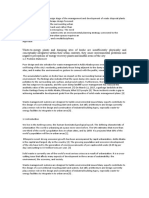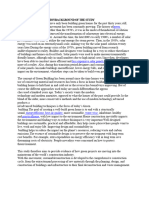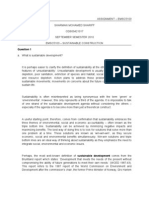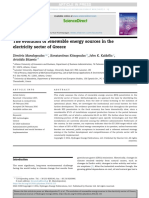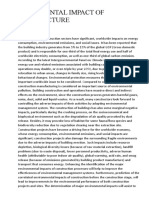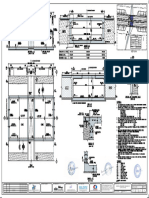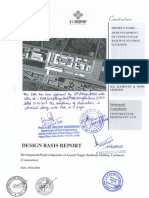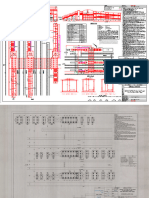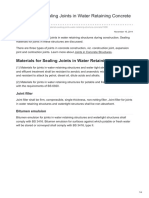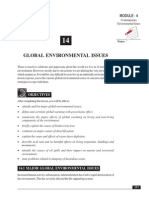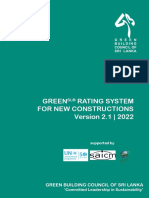Engineering To Live Within Planetary Boundaries
Engineering To Live Within Planetary Boundaries
Uploaded by
Kumar AtrayCopyright:
Available Formats
Engineering To Live Within Planetary Boundaries
Engineering To Live Within Planetary Boundaries
Uploaded by
Kumar AtrayOriginal Description:
Original Title
Copyright
Available Formats
Share this document
Did you find this document useful?
Is this content inappropriate?
Copyright:
Available Formats
Engineering To Live Within Planetary Boundaries
Engineering To Live Within Planetary Boundaries
Uploaded by
Kumar AtrayCopyright:
Available Formats
Engineering to live within
planetary boundaries
Civil engineering research needs
Registered charity number 210252
Charity registered in Scotland number SC038629
ENGINEERING TO LIVE WITHIN PLANETARY BOUNDARIES:
Civil Engineering Research Needs
The context for development is changing rapidly and it follows that the way we build and
maintain our infrastructure must change accordingly. To be successful this change will need
to be underpinned by a lively research and development base. This paper sets out a future
vision for the development of civil engineering in the broader context of one planet living. It
aims to highlight how the research agenda must change and considers how industry,
government and academia need to combine to deliver this ambitious programme. This short
briefing paper is not intended to be comprehensive, but rather sits alongside other ICE
initiatives in seeking to stimulate the transition needed to live within the boundaries set by our
planet.
What is Civil Engineering?
Civil Engineering is about creating, improving and protecting the environment in which we
live. It provides the facilities needed for commerce, industry and day-to-day life, such as
water and energy supply, transport and buildings.
Civil engineers design and build the infrastructure that surrounds us, providing transport,
energy and water distribution as well as the buildings in which we live and work. Our
infrastructure is designed to withstand a range of weather conditions and last for tens or
hundreds of years. This infrastructure adds to our quality of life, so much so that it is often
taken for granted and only noticed when parts of it fail, or are taken away.
A key aspect of developing and maintaining our infrastructure is to ensure that it is
sustainable, meeting our present needs without compromising the needs of tomorrow. While
increasing sustainability can be in part achieved through simple actions like recycling and
using public transport, it has a particular link with civil engineering. Use of sustainable
materials, reducing the energy needs over the whole life cycle and protection of the
environment are all ways in which civil engineers can ensure the sustainability of the projects
they undertake.
Most branches of engineering involve design work of some form and this is underpinned by
research into new technologies, materials and methods. What makes civil engineering
different is that, while components of a structure may be fabricated, much as in most other
branches of engineering that involve manufacturing processes, the structure itself is typically
unique a bespoke design and construction to meet the specific infrastructure needs matched
to the local environment and ground conditions. The sheer size of many projects also means
that it is often impractical to undertake large-scale tests, so that opportunities to test and
evaluate new, replicable techniques and materials need to be created as an integral part of
major civil engineering projects.
The developed world has a huge capital investment in existing infrastructure and as a
consequence there is an important ongoing requirement to maintain and update this
infrastructure to meet changing needs and conditions. Developing techniques to renew or
adapt existing infrastructure is now critical in ensuring that the built environment can be
maintained to meet the needs of present and future generations.
Context for future development of Civil Engineering
For civil engineering to play an active role in shaping the built environment, it is important to
appreciate the broader development context and to some extent anticipate the shape and
structure of society going forward. Change has always been a feature of the world in which
Research needs for Civil Engineering v4a: 11/08/2010 1
we live. However the rate of change is now increasingly rapid, bringing a number of
challenges arising from an increasing and ageing population accompanied by increasing
urbanisation, a vast infrastructure legacy that needs to be maintained or replaced, and the need
to move to a low carbon economy, whilst not further compromising biodiversity. This is not
being driven by a single issue (such as climate change) but is the result of the complex
interaction of many pressures bumping up against what the planet can actually provide. We
have therefore chosen to frame the future research agenda within the context of planetary
boundaries, as recently proposed by the science community.
Planetary Boundaries
The concept of planetary boundaries aims to assess the scale of human activity in relation to
the capacity of the Earth to sustain that activity1, based on the biophysical processes of the
Earth System that determine the self-regulating capacity of the planet. As such it aims to
identify the rules of the game within which human enterprise must operate to avoid changes
that may challenge social and ecological resilience at both regional and global scales. The
approach is relatively new and there is much work still to be done to ascertain the choice and
definition of a robust set of boundaries. However, the concept is clear and sufficiently
intuitive that we can begin to explore ways in which society can stay within such boundaries.
The processes on which boundaries are proposed include climate change, rate of biodiversity
loss, the nitrogen and phosphorous cycles, stratospheric ozone depletion, ocean acidification,
global freshwater use, land use, atmospheric aerosol loading and chemical pollution.
Considering what needs to be done to stay within (or get back within) the proposed
boundaries suggests a number of limits to human activities:
1. Controlling the level of greenhouse gases, most notably CO2, through a move to a low
carbon economy. This is largely the remit of the climate mitigation and energy security
agenda.
2. Ensuring that the emission of ozone depleting substances continues to be controlled.
3. Controlling (i) the fixation of nitrogen from the atmosphere and its subsequent flow into
land, ocean and atmospheric systems and (ii) the rate at which phosphorous flows to the
oceans. This may mean reducing the amount industrial and agricultural fixation of
nitrogen, and reduced fossil fuel combustion and biomass burning to manage the supply
side, in conjunction with measures to eliminate, control or capture nitrogen and
phosphorous in the various earth system pathways.
4. Limiting land system change by developing global spatial planning that reserves the most
productive land for agriculture and maximises the maintenance of key ecosystems in
their undisturbed or managed state. In some cases this may need to be spatially dynamic
and will also cascade down to impact on spatial planning at all scales.
5. Limiting the human consumption of water to ensure that there is sufficient capacity
within the water cycle to meet the needs of ecosystem functions and services in addition
to human needs.
6. Developing processes that reduce or eliminate various forms of atmospheric pollution,
such as dust or particle emissions, or the production of compounds including nitrates,
sulphates, ammonium and non-volatile organics.
7. Controlling or eliminating chemical pollution of earth systems, noting that this can itself
affect other planetary boundaries. In particular, ecosystem services are used extensively
to sequester pollutants with a longer-term and often cumulative impact.
1
Rockstrm J, Steffen W, Noone K, Persson A, Chapin FS, Lambin EF, Lenton TM, Scheffer M,
Folke C, Schellnhuber HJ, Nykvist B, de Wit CA, Hughes T, van der Leeuw S, Rodhe H, Sorlin S,
Snyder PK, Costanza R, Svedin U, Falkenmark M, Karlberg L, Corell RW, Fabry VJ, Hansen J,
Walker B, Liverman D, Richardson K, Crutzen P, Foley JA, 2009, A safe operating space for
humanity, Nature, 461(7263), 472-475.
Research needs for Civil Engineering v4a: 11/08/2010 2
8. Maintaining biodiversity is seen as key to ensuring continued system resilience and, in
particular, habitats and species that are structurally important to maintain specific
ecosystems. This is addressed in part by the conservation and sustainability agenda.
Many of these controls may be seen as environmental in character and it could be argued that
they are therefore the remit of environmental planners and managers. However, society
functions around an infrastructure that largely determines human interaction with the
environment. How we engineer that infrastructure in the future is therefore likely to have a
major influence on our ability to live within the sort of planetary boundaries being proposed.
Given the operational life of most infrastructure and the lead time for developing new
infrastructure, only by starting to make changes now can we hope to have an impact on our
encroachment of these boundaries over the next 20-50 years.
This is brought into sharper focus by two additional factors: (i) population growth and (ii)
finite natural resources. Taken together these factors mean greater pressure on a diminishing
resource of aggregates, minerals, fossil fuels, etc, as well as resources that should, with
responsible stewardship, be renewable. Thus access to traditional building materials is likely
to become more costly and, coupled with moves to minimise carbon use, alternative ways of
building or even delivering infrastructure services need to identified and developed.
Civil Engineering in a bounded world
For the civil engineer these issues are largely encapsulated in five key themes:
Climate change has become a dominant policy factor across the world. Public policy
statements at international and national level include targets for reducing carbon output from
human economic activities across a range of fields2. On the one hand, this is necessarily a
global endeavour but most of the actions required, in terms of both mitigation and adaptation
measures, will need to be undertaken at the local or regional.
Resource depletion, coupled with population growth, is now emerging as a serious constraint.
Oil: The forecast peak in world oil supplies means that energy prices could rise very
steeply within the next decade, perhaps within five years3. The developed world currently
uses 50Mb/d4 and total consumption is just over 80Mb/d. Production is currently about
84Mb/d and is set to increase to over 90Mb/d but demand, in particular increased demand
in the developing world, is forecast to grow to about 105Mb/d by 20305.
Water: at present there is enough fresh water on the planet to support the needs (but not
the excesses) of population of some 6 billion6. The problem is that the supply is not
evenly distributed and in water stressed areas abstraction can compound wider
degradation of the ecosystem. Today some 0.7 billion people live in areas of water
scarcity; this is set to more than double by 2025. The difference in per capita
consumption is (as with oil) stark, with developed countries using over an order of
magnitude more water per day per person (200-400 litres/day as against 10-12 litres/day).
2
Committee on Climate Change, December 2008, Building a low-carbon economy the UKs
contribution to tackling climate change
3
UK Industry Taskforce on Peak Oil & Energy Security (ITPOES), 2010, The Oil Crunch a wake up
call for the UK economy, Ove Arup & Partners, London
4
Mb/d million barrels per day
5
On a per capita basis, the OECD counties currently use 18b/year/person and the non-OECD countries
2b/year/person.
6
http://www.un.org/waterforlifedecade/scarcity.html
Research needs for Civil Engineering v4a: 11/08/2010 3
Mineral resources: minerals are considered unlikely to become resource limited until
about 20507. However, the uneven distribution of resources, the strong increase in
demand from developing countries and the concentration of certain key natural mineral
resources in areas of major geopolitical instability are all likely to increase the cost of raw
materials and change the economics for certain uses (e.g. choice of timber/concrete/steel)
Demography and social structures are also changing. The number and proportion of elderly
people in the population is forecast to increase significantly. In addition, the erosion of
established family and community structures is leading to changing patterns of economic and
social activity. These changes raise issues of how to adapt infrastructure to address social and
societal needs, whilst also supporting the economy.
Minimising environmental impact is well established through a variety of legal and
regulatory structures. The need to ensure that biodiversity is not compromised and, where
possible is enhanced, is now central to sustainable development. However, achieving this
alongside some of the other goals noted above frequently raises conflicts (often because
impacts occur at different scales). Finding alternate, or optimum, solutions is key to making
the transition to live within planetary boundaries, without compromising biodiversity in the
process.
Ageing infrastructure needs to be maintained or replaced. The developed world has a huge
investment in existing infrastructure and, as already noted, this is often take for granted or
assumed to be the status quo. However, all infrastructure entails a future commitment, which
may be as minimal as routine inspections but is more likely to entail planned maintenance and
an expectation that it will need to be replaced at some point in the future8. This does of
course provide opportunities for adapting infrastructure to changing needs but will need to be
anticipated and planned for if it is to be successful and resources are to be used efficiently.
Scope of research to meet these needs
An overarching vision is to promote well-being and social inclusion alongside contributing to
future economic growth, resilience and environmental protection, whilst living within
planetary boundaries. This equates, in effect, to sustainable development.
This vision in itself poses some major research questions:
Is it possible to do all of these things, or will it entail compromises?
What will such a future look like?
How do we transition to such a future?
How do we communicate and develop societal acceptance and adoption of the
changes needed to deliver such a vision?
A low carbon economy is a central component of the changes needed. Within the UK, the
Climate Change Act and the target set by government of an 80% reduction in emissions by
2050 sets a strong policy framework. The work of the UK Construction Industry Innovation
& Growth Team has begun to identify the changes that are needed within the industry to
move to a low carbon economy.
Changes introduced to meet new objectives may in themselves increase or change demand
(e.g. a shift to using electric cars as part of the move to a low carbon society), or bring the
industry sector into conflict with other legislative requirements (e.g. increased waste water
treatment to meet environmental needs, which increases energy use). There may therefore
7
Kesler SE, 2007, Mineral Supply and Demand into the 21st Century, U.S. Geological Survey,
Denver, USA, Circular 1294, pp. 55-62.
8
The ICE State of the Nation reports provides a regular assessment of the state of the UKs
infrastructure. See: http://www.ice.org.uk/News-Public-Affairs/State-of-the-Nation
Research needs for Civil Engineering v4a: 11/08/2010 4
also be a need to regulate demand, or compromise on socio-environmental objectives. In
either case, these are societal choices that will require public engagement and ultimately
support for the decisions made. It follows that civil engineering research may also have
significant implications for other sectors and may draw increased value from them. Thus
some civil engineering research will necessarily be collaborative.
A common emerging theme, when considering multiple objectives (an inevitable consequence
of planetary boundaries) is that of conflict. This is often around issues of scale or societal
preferences, such as:
Centralised versus de-centralised delivery
Renewable energy generation versus concerns over immediate environmental impact
Nuclear energy generation versus CO2 emissions
Reduction in CO2 emissions versus security of energy supply
Reduction in transports carbon impact versus freedom for dispersed travel choices
Energy versus resource conservation in the recovery of certain materials from wastes
Protecting the current environment versus letting nature take its course (eg. in
shoreline management)
Investment of energy and resource in fixed infrastructure versus use (eg high speed
rail versus flying) in transport systems
Use of scarce water resources for food, industry and people versus protecting or
enhancing the environment
Energy use for cleaning wastewater to higher standards versus commitments to
reduce carbon costs
For example, nuclear power is low carbon but is not classed as a renewable form of energy
generation. Some renewable energy schemes, such as the Severn Barrage, are contentious for
environmental reasons. There is therefore an urgent need to better understand how best to
meet energy needs whilst also addressing the commitment to reduce CO2 emissions. David
MacKay has set out the basis of a balance sheet9, but there remain numerous uncertainties and
huge scope to research better solutions for both the supply and demand sides of the balance
sheet.
Furthermore, optimum delivery modes often vary with scale. There are growing pressures to
provide alternatives to car use, especially through encouraging public transport development.
This is increasingly supported by the benefits for the economy from increasing the
opportunity for all individuals to gain far easier access to employment and services. However
the optimum solutions to deliver such benefits vary with scale (e.g. large city versus small
town) and the interaction with other aspects of our infrastructure (e.g. commercial and
residential buildings, power and water supply lines). Furthermore, while mass movements of
people are likely to remain, we can also anticipate that information exchange will continue to
develop rapidly and may fundamentally change the nature of many business transactions.
Understanding these scale effects and being able to optimise around them will be central to
improved planning and design in the future.
Research Topics to support this agenda
Some key aspects on which civil engineering research might focus to support the transition
towards a built environment that respect planetary boundaries are listed below. The planned
expenditure on UK infrastructure over the next five years is some 195bn10 with the values
next to the sector headings indicating the planned sector spend. The scope for research to
make significant savings, alongside improvements in the coherent delivery of infrastructure
designed to meet future, as well as present, needs is therefore significant. A similar
conclusion was reached in the recent EPSRC Review of Ground and Structural Engineering
9
MacKay D, 2009, Sustainable Energy without the hot air, UIT, Cambridge, England
10
Indicative estimates from HM Treasury & Infrastructure UK, 2010, Strategy for national
infrastructure (based on 2008/09 prices).
Research needs for Civil Engineering v4a: 11/08/2010 5
(2009), which also listed some of the research challenges based on the results of an online
survey11.
Transport (Planned 5 year UK spend of 69bn - 35%)
Develop materials and methods which enable transport infrastructure to be built more
efficiently and with the long-term needs clearly recognised.
Identify fully the links that infrastructure construction has with vehicles, equipment and
operation (e.g. light rail lines as total systems).
Identify efficient means of maintenance and developing materials and techniques for this.
Redesign railway track systems for better performance and reduced maintenance.
Develop methods for the cost-effective life extension of existing transport infrastructure
Understanding and overcoming barriers to modal shift
Energy (Planned 5 year UK spend of 57bn - 35%)
Continue research and development of wind, wave, tide, solar, hydro and pumped storage
schemes, with an emphasis on transformational step change improvements in components
and systems, e.g. the efficiency and effectiveness of offshore wind turbine foundations,
materials and reliability of components, ocean current and wave converter devices, etc.
Develop alternative forms of heating (combined heat and power, heat exchange, ground
and air source heat pumps, geothermal energy).
Research how to maintain a mix of power supplies through adaptation of existing plant
and upscaling of carbon capture and storage.
Find affordable ways of dealing with the nuclear contamination legacy.
Explore materials opportunities for both renewable and nuclear new builds.
Hazards (Floods, erosion, land slides, earthquakes, volcanoes, tsunamis,drought, etc)
Adapt existing infrastructure to cope with changing climate patterns.
Increase community resilience to hazard impacts.
Improve emergency response to hazards, particularly in places where there are limits to
climate adaptation
Examine the interaction between maintaining standards of hazard management and
maximising the opportunities for habitat creation and the maintenance of biodiversity.
Waste (Planned 5 year UK spend of 8bn - 4%)
Recover more materials from wastes, especially where this is in small
quantities/concentrations (e.g. rare elements and metals in electronic components).
Develop capability for a cultural shift to regard everything as a commodity and nothing as
waste.
Roll out the lessons of the Defra New Technologies Demonstrator Programme for the
treatment of biodegradable municipal solid waste into practice
Water and waste water (Planned 5 year UK spend of 27bn - 27%12)
Develop a better understanding of the risks of supply-demand deficits in the UK and its
implications for public water supply and food production
Establish a more integrated understanding of water systems in order to optimise water
supply, treatment and distribution processes.
Improve understanding of the links between water treatment processes (potable and
waste) and carbon recycling.
Develop methods for long-term water management planning that fully consider the
uncertainties related to climate and socio-economic change (real options, adaptive
management)
11
http://www.epsrc.ac.uk/SiteCollectionDocuments/other/2009gsereview/futurechallenges.pdf
12
Includes flooding
Research needs for Civil Engineering v4a: 11/08/2010 6
Communications (Planned 5 year UK spend of 35bn - 24%)
Improve the use of communication technology in the planning and delivery of
infrastructure and as an integral part of technology to support activities such as
maintenance, emergency warning and surveillance (infrastructure security).
Infrastructure planning
Examine the interactive influence of scale for decisions within and between infrastructure
sectors. Typically this relates to choices at local, regional or national scale and between
public and private led initiatives (e.g. public transport versus private, local power
generation versus national grid, catchment management versus national water
distribution, etc).
Facilitate the integration of infrastructure planning and management with spatial planning
and other fields (multi-disciplinary research needed).
Identify opportunities for multi-purpose operations, such as waste treatment with
combined heat and power.
Complex interactive networks critical infrastructure
Improve the modelling of infrastructure systems and increase our understanding of the
systematic interaction of infrastructure sectors.
Understand the optimum use and implications of energy regeneration in transport and its
applications (e.g. electrified railway and light rail lines, scope for using KERS on diesel
road and rail vehicles).
Address the interaction of civil engineering with communities and the way in which
societal aspirations will influence future civil engineering projects.
Security
Develop more resilient networks and safer places.
Determine how to deliver security of supply (energy, water, transport network, etc) with
minimum overhead costs.
Explore response options in the event of critical system failures, including a better
understanding of human reactions.
Design and Construction
Develop a standardised industry-led infrastructure carbon accounting model.
Research techniques for the remediation of infrastructure earthworks to combat the
effects of ageing and climate change.
Examine the design life of existing infrastructure and implications for life extension,
reduced maintenance and improved reliability.
Find innovative approaches/solutions to adapting existing infrastructure to cope with
climate change.
Review design criteria and develop new guidance in response to climate change.
Explore opportunities to better involve communities in the design and construction
process.
Develop robust and sustainable construction materials with reduced embodied
energy/carbon footprint
Explore the opportunities presented for incorporating biological processes and
developments in nanotechnology, in the design and construction of dynamic or responsive
structures.
Continue research into improving the energy performance of existing and new buildings,
taking account of the constraints associated with the need to retro-fit measures and the
interactions with user needs and behaviour.
Research needs for Civil Engineering v4a: 11/08/2010 7
Short term actions
Research is an ongoing process. This means that there are some developments that are close
to fruition and others that could be translated into applications relatively quickly. Some
examples include:
Promulgate and implement the findings of the recently completed Defra demonstrator
programme on technologies for the treatment of biodegradable municipal solid waste.
Find new ways of developing standards and guidance rapidly (e.g. using semantic web
technology) to meet the need for more rapid feedback from novel prototype to industry
adoption.
Improve the definition of the infrastructure asset base (with ready access to the research
community).
Investigate why some innovations are slow to be taken up compared with other countries
(e.g. CHP, electric vehicles, light rail) to better understand the barriers to adoption. This
may have significant implications for the rapidly developing adaptation agenda13.
Devise appropriate methods to retro-fit energy efficiency measures to the existing
domestic and commercial building stock.
Investigate the effects of human interaction effects on energy efficiency and how they can
be mitigated or managed.
Develop monitoring and evaluation protocols to assess the real effectiveness of energy
efficiency measures in new and existing buildings.
Over the very short-term, financial constraints on budgets means that the focus for the
industry will be on the more for less agenda. The research agenda will need to follow this
by delivering ever improving capacity for efficient project delivery. This will emphasize the
need for collaborative research which identifies the role of civil engineering research in
achieving efficiency gains against public goals. Furthermore, it is essential that we do not
loose sight of the longer-term agenda, as set out above, and ensure that infrastructure
commitments made now do not lock out opportunities for the future.
Impact and benefits
Investment in infrastructure can provide enormous value to the economy, increasing the long-
term rate of growth and helping to meet many other government objectives. One estimate
suggests that the UK may need to invest in excess of 400 billion14 on new and refurbished
infrastructure by 2020 to address historic under-investment15 and speed the transition to a low
carbon economy. However, the current financial crisis has however placed an enormous
pressure on public finances, reduced the availability and increased the cost of private
capital16. Thus in the short-term the test for research and development will need to be
focussed on:
What will bring rapid socio-economic benefit?
More generally, though, the recurring themes in infrastructure are the long lead times and the
relatively long life of most structures (at least several decades - much of waste water
infrastructure is a result of Victorian investment). This locks society into planning and
infrastructure decisions for a long time. There is therefore an urgent need for an active
research agenda, with a clear route through to industry uptake, that addresses issues related to
climate change, the move to a low carbon economy, the development of alternative
techniques to cope with resource constraints and reduced environmental impact. This means
13
http://www.defra.gov.uk/environment/climate/programme/across-government.htm
14
Helm D, Wardlaw J, Caldecott B, 2009, Delivering a 21st Century Infrastructure for Britain, Policy
Exchange, London.
15
OECD, 2007, Economic Survey of the UK
16
ICE, 2010, A manifesto for UK Infrastructure
Research needs for Civil Engineering v4a: 11/08/2010 8
that in the medium-term the acid test of whether research is delivering what is needed is more
likely to be:
What will deliver a vibrant economy in which the UK plays its part in reducing the
pressure on planetary boundaries?
In either case, rapid uptake of the research results into civil engineering practice is essential.
This can be achieved by linking research programmes into major civil engineering projects.
One recent example of this was during construction of the Jubilee Line Extension17, which
enabled or facilitated seminal research on
Building movements due to tunnelling, and the mitigation of ground movements by
compensation grouting18
Temporary prop loads in large excavations19
The project also made use of groundwater control systems previously, in which expertise and
understanding had been developed in research carried out on the A55 Conwy Crossing some
years previously20.
An industry body such as the ICE could act as a focus for bringing together the industry and
the research teams, with bodies such as CIRIA21 and Constructing Excellence providing the
means of compiling the research results into practice guides.
Some evidence for the direct benefit of research to UK provided by translational research
undertaken by Research and Technology Organisations is provided by the study undertaken
by Oxford Economics22. A key element of the economic impact of the Intermediate Sector
on UK productivity reflects the large amount of research and development (R&D) it
undertakes (~400m in 2006). In addition, the sector generates a significant spill over effect
where this R&D is taken up in other sectors, providing a substantial additional contribution to
GDP and a substantial multiplier on the R&D investment.
Research infrastructure
The research infrastructure needs to develop to ensure the continued health of blue skies
research, and to improve the routes for pulling it through into applied research and into
practice. Importantly, there is a need for constant two-way flow of information between
practitioners and researchers, proactive management and much greater recognition of the
benefits of research and innovation in the procurement process.
It is widely recognised that the UK has a world class science and engineering research base
and yet the UK has consistently struggled to convert research breakthroughs into commercial
products. There is good evidence23 that a high level of support is necessary to take ideas
through to market. Indeed, this transition phase is often referred to as the valley of death, in
recognition of the fact that so many good ideas founder at this stage.
A recent report prepared for the last government suggest that a network of elite business-
focused national Technology and Innovation Centres (TICs) would provide an appropriate
17
http://www.omegacentre.bartlett.ucl.ac.uk/studies/cases/metro-london_jubilee.php
18
Building Response to Tunnelling: Case studies from Construction of the Jubilee Line Extension,
London (2 vols), Thomas Telford, 2001
19
D Twine and H Roscoe (1999). Temporary propping of deep excavations guidance on design.
CIRIA Report C517. London: Constriction Industry Research and Information Association
20
W Powrie & T O L Roberts (1990). Field trial of an ejector well dewatering system at Conwy, North
Wales. Quarterly Journal of Engineering Geology 23(2), 169-185
21
Construction Industry Research and Information Association
22
Oxford Economics, 2007, Study of the impact of the Intermediate Research and Technology Sector
on the UK economy
23
http://www.cleanenergystates.org/CaseStudies/NREL-Bridging_the_Valley_of_Death.pdf
Research needs for Civil Engineering v4a: 11/08/2010 9
focus for this endeavour24. There used to be a strong network of government laboratories that
undertook research to extend the capability of the construction industry. Since the early 80s
all of these laboratories have been privatised and most now do a mix of commercial and
academic research, with funding from industry, government and research funders (UK and
international). Inevitably, the gradual withdrawal of public funding from these organisations
has led to a reduction in generic R&D activities in favour of various mixes of applied
research, laboratory services and technical consultancy25. Given the rapid rate of research
application now needed to reduce the legacy cost of current methods, much greater support
is needed from both industry and government for bodies that undertake the translation of
generic research into applications and guidance for practice. Whether TICs are to be
established or not, the existing Research and Technology Organisations (RTOs) provide a
ready vehicle for the construction industry to establish the necessary capability (see
AIRTO26). The National Technology Platform and the Technology Strategy Board will be
important in stimulating research take-up and, coupled with the Infrastructure Technology
Strategy proposed by Infrastructure UK27, this could provide an effective focus for
infrastructure R&D.
In some quarters there is a misplaced perception that RTOs simply compete with universities
or consultants, whereas there is substantial evidence that RTOs are recognised by industry as
partners that enhance what universities have to offer18:
Fraunhofers many An-Institute with universities in Germany;
TNOs participation in Technological Top Institutes with universities and enterprises in
the Netherlands;
Sintefs organic links with the Norwegian Institute of Technology;
CEAs 62 joint research facilities with universities and research organisations in France;
HR Wallingfords Fluid Earth initiative for university partnering and the BRE Trust
initiative for University Centres of Excellence in the UK28
In these examples, the skills of RTOs and universities are found to be complementary, their
relationships synergistic, mutually beneficial and long-term. The present need is to improve
the interaction between academia and industry, where the RTOs can provide a well trained
resource that is already capable of doing this in some areas.
Another consideration is the financial model needed. In many areas of research, the
development of a new idea leads to patents or the ability to commercialise the idea in some
way. In civil engineering this tends not to be the case. Generally, ideas will only be accepted
and adopted if they are published and made accessible to all the opposite of the
conventional patenting approach. There are at least three contributing reasons for this:
much of the funding for infrastructure is, ultimately, from the public sector;
the paramount importance of public safety means that full disclosure is often a
prerequisite for adoption (Ciceros law);
there is an established resistance in the industry, which often leads to reinvention in
preference to adoption of existing but protected technologies.
24
Hauser H, 2010. The Current and Future Role of Technology and Innovation Centres in the UK,
Report for Lord Mandelson, Secretary of State Department for Business Innovation & Skills
25
EARTO, 2007, Research and Technology Organisations in the Evolving European Research Area:
A status reporting with policy recommendations
http://www.earto.eu/fileadmin/content/03_Publications/RTOs_and_the_Evolving_European_Research
_Area_WhitePaperFinal.pdf
26
Association of Independent Research and Technology Organisations (www.airto.co.uk) Research
and Technology Organisations (RTOs), operate on both a commercial and not-for-profit basis. AIRTO
currently represents around 50% of the intermediate sector between academia and the end-users of
technology.
27
HM Treasury & Infrastructure UK, 2010, Strategy for national infrastructure
28
https://fluidearth.net and http://www.bre.co.uk/bretrust/
Research needs for Civil Engineering v4a: 11/08/2010 10
The fact that most civil engineering schemes tend to be unique also contributes to the need for
the research support framework to be different.
Taking account of the above issues, one way forward would be to put in place a framework to
encourage a closer working partnership between funders, industry and academia. This might
be done by:
1. encouraging the Research Councils to procure and fund the fundamental research
required to address some of the strategic needs identified
2. stimulating closer working between industry and academia, making use of RTOs where
they have a role to play. This might involve fiscal measures, such as re-focussing R&D
tax credits to science and engineering research that has a societal or environmental
benefit, rather than having to be primarily an advance in science29.
3. progressing some of the research to address long-term societal needs by embedding this
as a requirement within a construction scheme procurement process.
It may be that some overall co-ordination is needed but the primary requirement is to provide
the financial stimulus to encourage parties to work together. Depending on how the role of
Infrastructure UK develops, the promotion of such changes and any overall co-ordination
necessary may be something that they could take on.
Also in relation to overall co-ordination, building on an approach already being implemented
in the UK in certain research areas, it seems likely that large scale civil engineering research
facilities will need to be established as UK Centres of Excellence/Expertise, selected not only
to achieve academic/industrial excellence but also an appropriate regional distribution.
Wasteful competition at a strategic level will thus be eliminated. Competition between
research consortia to use such facilities will obviously remain.
It has been estimated that the UK will need to recruit over half a million new workers into
engineering and manufacturing in the period 2007-1730. There is therefore a short-term
imperative for education and training to produce a work force capable of delivering
infrastructure against the revised criteria that will increasingly govern the design and
implementation process.
It is important to bear in mind that current UK research spend through the research councils
contains significant funds for research studentships. Furthermore a portion of a Councils
research grants portfolios may include expenditure on personnel. Education and training at
postgraduate research level already has, therefore, a strong presence. It is vitally important to
maintain this level of expenditure, particularly at PhD level, in the coming years.
Further skills shortage issues will also need to be addressed through the lifelong
learning/widening access agenda. Mechanisms need to be developed that provide a rapid
feedback from application, through lessons learnt to updating of education material.
For the civil engineering community at large the role of the so-called post graduate taught
student is of vital importance, i.e. one year Masters courses in specialised subjects. These
courses not only provide personnel at the appropriate skills level that are of great value to UK
industry, but also provide an excellent framework via a modular approach for the whole life
long learning agenda. These can be taught via e-learning techniques, and also provide an
excellent grounding for entry into PhD studies.
Moving to a low carbon economy needs standards, guidelines and training at all levels. Given
the lead time and life of most infrastructure, this needs to be made available as quickly as
possible if we are to make a significant difference within a timescale of 20-30 years. This will
29
http://www.bis.gov.uk/policies/innovation/business-support/rd-tax-credits/tax-guidelines
30
Engineering UK, 2009, Engineering UK 2009/10
Research needs for Civil Engineering v4a: 11/08/2010 11
involve close working between the industry and providers of both higher education and
continuing professional development (e.g. CIRIA and Constructing Excellence).
The need for rapid action and feedback means that procurement also needs to include R&D
focussed on the long-term objectives of infrastructure schemes to explore alternatives and
identify the best option. There have recently been some moves towards scheme evaluation
that considers how climate change may influence decisions over time31. Developments in
carbon accounting mean that financial and carbon costs will increasingly be considered in
tandem. However, in the context of planetary boundaries, there may be a need to broaden this
further to multiple criteria, using suitable optimisation tools to identify the best option(s).
Conclusions and Recommendations
We propose a vision for civil engineering to promote well-being and social inclusion
alongside contributing to future economic growth, resilience and environmental protection,
whilst living within planetary boundaries.
Whilst in the very short-term this may need to focus on rapid economic benefit, we suggest
that this moves quickly to an emphasis on:
delivering a vibrant economy in which the UK plays its part in reducing the pressure on
planetary boundaries
Some of the research needed to deliver this vision have been outlined and we would
emphasise two aspects of this agenda:
(i) The need for multi-disciplinary research and cross-profession collaboration to deliver
the change needed
(ii) The need for rapid development of the research base to underpin integrated planning
at multiple scales that recognises the interplay of complex dynamic networks.
Finally, we have endeavoured to explain why civil engineering needs a new framework for
research translation. This needs to go beyond initiatives such as the Knowledge Transfer
Networks, which have largely operated at the fringes of the industries needs. We have
proposed one way of establishing the conditions needed to generate and sustain a more
proactive relationship between industry and academia, which we believe is necessary if the
industry is to respond to very real limits to human activity and the need to live within the
planetary boundaries that we believe must underpin all future developments.
We would encourage Infrastructure UK, or some other appropriate arm of government, to
implement a number of steps that would encourage a closer working partnership between
funders, industry and academia, namely to:
encourage the Research Councils to promote the fundamental research required to address
the strategic needs identified;
stimulate closer working between industry and academia, making use of RTOs where
they have a role to play. This might involve fiscal measures, such as re-focussing R&D
tax credits to science and engineering research that has a societal or environmental
benefit, rather than having to be primarily an advance in science;
progress some of the research to address long-term societal needs by embedding this as a
requirement within construction scheme procurement processes.
There may be other ways of achieving the same objective and we would encourage the
industry, working with government, to seek a solution that can be adopted as quickly as
possible.
31
HM Treasury Green Book. www.hm-treasury.gov.uk/d/green_book_complete.pdf and
www.defra.gov.uk/environment/climate/documents/adaptation-guidance.pdf
Research needs for Civil Engineering v4a: 11/08/2010 12
Panel Members:
Ian Townend (Chair); William Powrie; Reg Harman; Hywel Thomas; Owen Jenkins; Roger
Venables; Mike Chrimes
Cite as:
ICE, 2010, Engineering to live within Planetary Boundaries: Research Needs for Civil
Engineering, Institution of Civil Engineers, London, p1-12.
Research needs for Civil Engineering v4a: 11/08/2010 13
You might also like
- GAWA Year 12 Sem 1 2022 - Exam Marking Guide For Teachers OnlyDocument32 pagesGAWA Year 12 Sem 1 2022 - Exam Marking Guide For Teachers OnlysponNo ratings yet
- Introduction To Environmental EngineeringDocument156 pagesIntroduction To Environmental EngineeringMaricar HababagNo ratings yet
- The Sustainability Implications of Building Adaptive Reuse: DR Langston CADocument11 pagesThe Sustainability Implications of Building Adaptive Reuse: DR Langston CAGail VoirNo ratings yet
- Challenges Faced by CEDocument3 pagesChallenges Faced by CEMarzhan KabdrakhmanNo ratings yet
- The Sustainability Implications of Building Adaptive Reuse: Epublications@BondDocument12 pagesThe Sustainability Implications of Building Adaptive Reuse: Epublications@BondInas AbdelsabourNo ratings yet
- Building Life CycleDocument10 pagesBuilding Life CyclefarhanadNo ratings yet
- Pertemuan 1 Pembangunan Infrastruktur Berwawasan Lingkungan: Dosen Pengampu Anie Yulistyorini, ST., MSC., PHDDocument34 pagesPertemuan 1 Pembangunan Infrastruktur Berwawasan Lingkungan: Dosen Pengampu Anie Yulistyorini, ST., MSC., PHDRESTARI RESTARINo ratings yet
- Position Paper EnvironmentDocument6 pagesPosition Paper EnvironmentitsmejavNo ratings yet
- Sustainable Management and Transformations of Cultural LandscapesDocument4 pagesSustainable Management and Transformations of Cultural LandscapesAR. PRIYANKA RASTOGINo ratings yet
- Landscape and Climatic DesignDocument12 pagesLandscape and Climatic DesignhariniNo ratings yet
- Cheng 2020 InnovationDocument3 pagesCheng 2020 Innovationcarly ceeNo ratings yet
- Professional Ethics and Human Values: Assignment 1Document15 pagesProfessional Ethics and Human Values: Assignment 1AGAJAAN FILMSNo ratings yet
- JstorDocument13 pagesJstorbackupvasiliki2No ratings yet
- Module 1 SseDocument11 pagesModule 1 SseSwathi SNo ratings yet
- Sustainable Architecture - Practices and Methods To Achieve Sustainability in Construction (B. Marques, 2013)Document5 pagesSustainable Architecture - Practices and Methods To Achieve Sustainability in Construction (B. Marques, 2013)Razi MahriNo ratings yet
- Calculo Huella CarbonoDocument9 pagesCalculo Huella CarbonoSantiago Felix Mota PaezNo ratings yet
- Mediu - The Impacts of ConstructionDocument6 pagesMediu - The Impacts of ConstructionAndreea MihaiNo ratings yet
- Climatic DataDocument9 pagesClimatic Datapucca123 TayNo ratings yet
- ASPECDocument7 pagesASPECMickaela Kassandra P. ParanNo ratings yet
- Poff Et Al 2015 NCCDocument16 pagesPoff Et Al 2015 NCCanelisamaqabukaNo ratings yet
- Group 3 Term PaperDocument38 pagesGroup 3 Term PaperFarouq LawalNo ratings yet
- Infrastructure StrategyDocument182 pagesInfrastructure StrategyPeterNo ratings yet
- CeoDocument2 pagesCeoPrincess WarriorNo ratings yet
- Task 6: Global Warming: KKKH 4284 Sustainable Urban PlanningDocument4 pagesTask 6: Global Warming: KKKH 4284 Sustainable Urban PlanningWan TalhahNo ratings yet
- Sustainable ArchitectureDocument5 pagesSustainable ArchitectureRica JoyceNo ratings yet
- Wedeconsult SehedDocument4 pagesWedeconsult SehedNetsanet AyalewNo ratings yet
- Sustainable Construction and Green Buildings On The Foundation of Building EcologyDocument4 pagesSustainable Construction and Green Buildings On The Foundation of Building EcologyKrishna RaiguruNo ratings yet
- Research PaperDocument32 pagesResearch Paperjudygabr24No ratings yet
- Articulo CientificoDocument10 pagesArticulo CientificoYolix RodriguezNo ratings yet
- Materia:: Ing - Amadeo Lira VazquezDocument14 pagesMateria:: Ing - Amadeo Lira VazquezIsrael Ambrosio GallegosNo ratings yet
- Sustainable Architecture: Practices and Methods To Achieve Sustainability in ConstructionDocument4 pagesSustainable Architecture: Practices and Methods To Achieve Sustainability in ConstructionSafirannurNo ratings yet
- Assignment 1 EeDocument12 pagesAssignment 1 EeAHSAN SHAHBAZNo ratings yet
- Green ConstructionDocument11 pagesGreen ConstructionJay-ra DaligdigNo ratings yet
- Technology Impact On Construction IndustryDocument14 pagesTechnology Impact On Construction IndustryVanessa PallarcaNo ratings yet
- Global WarmingDocument10 pagesGlobal WarmingAh ZhouNo ratings yet
- 2 What Impact Does A Construction of A New Building Have On EnvironmentDocument20 pages2 What Impact Does A Construction of A New Building Have On Environmentkruti makadiaNo ratings yet
- Climate Change Impacts On and Actions From The Construction IndustryDocument10 pagesClimate Change Impacts On and Actions From The Construction IndustryBraylon RobinsonNo ratings yet
- Development of A Framework For The Valuation of Eco-System Services of Green InfrastructureDocument7 pagesDevelopment of A Framework For The Valuation of Eco-System Services of Green InfrastructureVaruniJayasooriyaNo ratings yet
- An Overview of Water Sensitive Urban Design Practi PDFDocument9 pagesAn Overview of Water Sensitive Urban Design Practi PDFyamini sainiNo ratings yet
- Sustainable ConstructionDocument18 pagesSustainable ConstructionSharman Mohd Shariff100% (1)
- Appraisal of Sustainable Construction Practices in Lusaka, ZambiaDocument11 pagesAppraisal of Sustainable Construction Practices in Lusaka, ZambiaMichael MatshonaNo ratings yet
- Bioclimatic ArchitectureDocument10 pagesBioclimatic ArchitectureGio RiscaNo ratings yet
- Manolo Poulos 2016Document13 pagesManolo Poulos 2016kalokosNo ratings yet
- A Case Study in Analyzing The Impact of Climate Change On Highway InfrastructureDocument31 pagesA Case Study in Analyzing The Impact of Climate Change On Highway InfrastructureKouhaii RezNo ratings yet
- The Unsustainability of Sustainable ArchitectureDocument18 pagesThe Unsustainability of Sustainable ArchitectureVictor OuruNo ratings yet
- Jessica A.Document7 pagesJessica A.joselleNo ratings yet
- A Model For Appraising The Sustainability of BridgesDocument8 pagesA Model For Appraising The Sustainability of BridgesAbdikarim ObahleNo ratings yet
- Development of A Framework For The Valuation of Eco-System Services of Green InfrastructureDocument8 pagesDevelopment of A Framework For The Valuation of Eco-System Services of Green InfrastructureVaruniJayasooriyaNo ratings yet
- Green Building Designing Innovation in India A Literature Review PDFDocument8 pagesGreen Building Designing Innovation in India A Literature Review PDFBulbul SahuNo ratings yet
- 8green Roof More About SustainabilityDocument17 pages8green Roof More About SustainabilityForsythe LearningNo ratings yet
- Handbook of Green Building Des6d7b8f7089cb - Anna's Archive 39Document1 pageHandbook of Green Building Des6d7b8f7089cb - Anna's Archive 39gamedesigning87No ratings yet
- Energy Management and Green Development (Compatibility Mode)Document31 pagesEnergy Management and Green Development (Compatibility Mode)surabhi kumariNo ratings yet
- The Engineer and The Environmentalist: 11th March 2020 12:57 PMDocument3 pagesThe Engineer and The Environmentalist: 11th March 2020 12:57 PMEduardo RicciNo ratings yet
- Hall Et Al. 2020Document4 pagesHall Et Al. 2020assignmentreliabilityNo ratings yet
- MitDocument197 pagesMitMukesh WaranNo ratings yet
- Detailed Analysis of Sustainable Infrastructure Design and Benefits For Urban CitiesDocument14 pagesDetailed Analysis of Sustainable Infrastructure Design and Benefits For Urban CitiesalimeNo ratings yet
- Melchert 2007Document9 pagesMelchert 200720105023No ratings yet
- ENVIRONMENTAL IMPACT OF BUILDSTRUCTURE IntroductionDocument8 pagesENVIRONMENTAL IMPACT OF BUILDSTRUCTURE IntroductionAmey BundeleNo ratings yet
- Cumulative Effects of Planned Industrial Development and Climate Change On Marine EcosystemsDocument7 pagesCumulative Effects of Planned Industrial Development and Climate Change On Marine EcosystemsAlejandro El GrandeNo ratings yet
- 1 12+883 1 X 3 X 4 QD QC, Hence, OK. Sufficient Culverts Has Been Provided For The CatchmentDocument4 pages1 12+883 1 X 3 X 4 QD QC, Hence, OK. Sufficient Culverts Has Been Provided For The CatchmentKumar AtrayNo ratings yet
- Cipl-D1114-Str-Dwg-Lvup-7+822-100-Sh 1Document1 pageCipl-D1114-Str-Dwg-Lvup-7+822-100-Sh 1Kumar AtrayNo ratings yet
- 1185 MJB 18+974 Design of Well FoundationDocument77 pages1185 MJB 18+974 Design of Well FoundationKumar AtrayNo ratings yet
- DESIGN OF BOX CULVERT OF SIZE 1x5.0x2.1Document52 pagesDESIGN OF BOX CULVERT OF SIZE 1x5.0x2.1Kumar AtrayNo ratings yet
- 1707997051163-Sl No 8 2Document1 page1707997051163-Sl No 8 2Kumar AtrayNo ratings yet
- DIMENSIONAL DRAWINGS OF BOX CULVERT OF SIZE 1x5.0x1.5Document1 pageDIMENSIONAL DRAWINGS OF BOX CULVERT OF SIZE 1x5.0x1.5Kumar AtrayNo ratings yet
- Design of Abutment A1-A2 Pile 2X16m Ch.3+992Document95 pagesDesign of Abutment A1-A2 Pile 2X16m Ch.3+992Kumar AtrayNo ratings yet
- DIMENSIONAL DRAWINGS OF BOX CULVERT OF SIZE 1x5.0x2.1Document1 pageDIMENSIONAL DRAWINGS OF BOX CULVERT OF SIZE 1x5.0x2.1Kumar AtrayNo ratings yet
- 1707816221439-Sl No 3 1Document1 page1707816221439-Sl No 3 1Kumar AtrayNo ratings yet
- 1707997004134-Sl No 8 1Document1 page1707997004134-Sl No 8 1Kumar AtrayNo ratings yet
- Design of Box Plate and Concrete BlockDocument4 pagesDesign of Box Plate and Concrete BlockKumar AtrayNo ratings yet
- Ghaziabad - Structural Drawings - Buildings - City SideDocument17 pagesGhaziabad - Structural Drawings - Buildings - City SideKumar AtrayNo ratings yet
- Bangalore Cantt - Structural Drawings FOB Part 4Document8 pagesBangalore Cantt - Structural Drawings FOB Part 4Kumar AtrayNo ratings yet
- Why Weight Training Not Cardio Is The Key To Lasting Fat LossDocument4 pagesWhy Weight Training Not Cardio Is The Key To Lasting Fat LossKumar AtrayNo ratings yet
- Ghaziabad - Structural DBR - FOB and ConcourseDocument88 pagesGhaziabad - Structural DBR - FOB and ConcourseKumar AtrayNo ratings yet
- Prayagraj - Structural DBRDocument23 pagesPrayagraj - Structural DBRKumar AtrayNo ratings yet
- Ghaziabad - Structural DBR - BuildingsDocument29 pagesGhaziabad - Structural DBR - BuildingsKumar AtrayNo ratings yet
- Gomti Nagar - Structural DBR - Air ConcourseDocument34 pagesGomti Nagar - Structural DBR - Air ConcourseKumar AtrayNo ratings yet
- Foundation Drawings of 12m Wide FOB at KALKADocument9 pagesFoundation Drawings of 12m Wide FOB at KALKAKumar AtrayNo ratings yet
- December 2016 Examination DCA 01 Management Information System Time: Three Hours Maximum Marks: 100Document2 pagesDecember 2016 Examination DCA 01 Management Information System Time: Three Hours Maximum Marks: 100Kumar AtrayNo ratings yet
- Structural Engineering Forum of India SefiDocument16 pagesStructural Engineering Forum of India SefiKumar AtrayNo ratings yet
- Materials For Sealing Joints in Water Retaining Concrete StructuresDocument4 pagesMaterials For Sealing Joints in Water Retaining Concrete StructuresKumar AtrayNo ratings yet
- 7 DDocument3 pages7 DBabita RawatNo ratings yet
- Biodiversity LuceroDocument2 pagesBiodiversity LuceroJessaNo ratings yet
- Sustainability Practices in Oil and Gas IndustryDocument2 pagesSustainability Practices in Oil and Gas IndustryDipakNo ratings yet
- Mkounnas ProgramproposalDocument8 pagesMkounnas Programproposalapi-450126310No ratings yet
- Solar DesalinationDocument2 pagesSolar DesalinationshokryNo ratings yet
- 6 Chapter of Odum-EcologyDocument19 pages6 Chapter of Odum-EcologyMaster MirrorNo ratings yet
- 11.16.2021 Noreaster UpdateDocument12 pages11.16.2021 Noreaster UpdateActionNewsJaxNo ratings yet
- 14 - Global Environmental IssuesDocument22 pages14 - Global Environmental Issuesshanujss100% (2)
- Class 7 - Social Science - G8. Tropical and Sub Tropical Regions - NotesDocument4 pagesClass 7 - Social Science - G8. Tropical and Sub Tropical Regions - NotesDiya shivNo ratings yet
- Assessment of Stream Quality and Health Risk in A Subtropical Turkey River 2020 OkDocument12 pagesAssessment of Stream Quality and Health Risk in A Subtropical Turkey River 2020 OkKumar VivasNo ratings yet
- Aquarium Strategy ENDocument90 pagesAquarium Strategy ENSandeep SinghNo ratings yet
- EUDRDocument4 pagesEUDRThilina NirangaNo ratings yet
- Exogenic Processes: Physical and Chemical Weathering: Pamantasan NG Lungsod NG MuntinlupaDocument25 pagesExogenic Processes: Physical and Chemical Weathering: Pamantasan NG Lungsod NG MuntinlupaRheaNo ratings yet
- (Pre-Final) Solid and Hazardous WasteDocument74 pages(Pre-Final) Solid and Hazardous WasteMarkNo ratings yet
- SEE211 Energy, Climate Change and SustainabilityDocument20 pagesSEE211 Energy, Climate Change and Sustainabilitypm020202pmNo ratings yet
- What Is The Sustainable Development Definition For Class 10?Document4 pagesWhat Is The Sustainable Development Definition For Class 10?Hassan Raza80% (5)
- GREEN Rating System V 2.1Document156 pagesGREEN Rating System V 2.1Gobidan NavanesanNo ratings yet
- Eng1201 Lit Review Zoos Thurte1Document4 pagesEng1201 Lit Review Zoos Thurte1api-608928001No ratings yet
- UntitledDocument8 pagesUntitledJervin ManabatNo ratings yet
- Article Writing Class 8Document2 pagesArticle Writing Class 8Machhindra DahifaleNo ratings yet
- Midterm Test 2 - DH12 - 2.11Document4 pagesMidterm Test 2 - DH12 - 2.11Lâm Thị Thu PhươngNo ratings yet
- Water Resources Engineering - I-15-16 PDFDocument3 pagesWater Resources Engineering - I-15-16 PDFSai Charishma100% (1)
- A Sustainable Ecotourism Management For Mt. ApoDocument8 pagesA Sustainable Ecotourism Management For Mt. ApoSarahLabadan100% (2)
- FR 01Document275 pagesFR 01Arun KumarNo ratings yet
- BiodiversityDocument6 pagesBiodiversityLary Bags100% (1)
- Endangered SpeciesDocument6 pagesEndangered Speciesmartin pontNo ratings yet
- Atmosphere Study GuideDocument2 pagesAtmosphere Study GuideKeyton OwensNo ratings yet
- Reading List - Water Wastewater Engineering - 2013Document4 pagesReading List - Water Wastewater Engineering - 2013amrezzat82No ratings yet
- Environmental Science: Ms. Suzzeth M. RamirezDocument54 pagesEnvironmental Science: Ms. Suzzeth M. RamirezKalel Jocen DavidTubeNo ratings yet

























